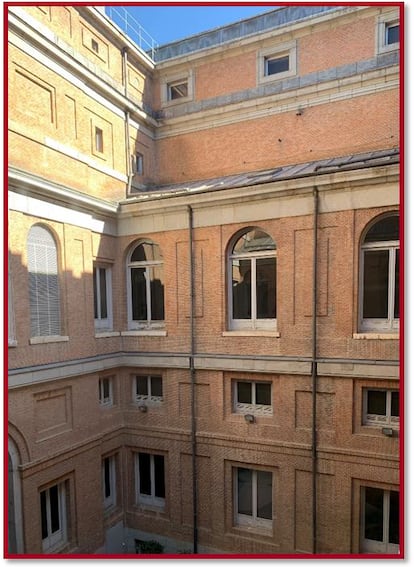The Royal Academy of Fine Arts of San Fernando issued two reports asking the Prado Museum to remove the signs on the facades of Goya, Velázquez and Murillo (main and side) where the name of the art gallery is read, because “no one has ever needed signs with the name of the institution to know that it was in front of the building of the Prado Museum, just as no one needs to know that it is in front of the Royal Palace of Madrid or the cathedral of Burgos”. The letters, they continue, “alter with their presence the three classical porticoes, which were conceived without them and which have remained so for more than two hundred years without anyone having missed them”. They compare the emblematic building of architect Juan Villanueva (1739-1811) with “the best of his masterpieces of painting or sculpture” that the museum can currently house, so its appearance cannot be changed. Dal Prado show “enormous surprise” at this request, “especially when the main museums in the world have these signs, as do numerous protected buildings in Madrid, including that of the Royal Academy, which now asks us to remove ours”.
In the case of the Velázquez gate and its Doric portico, the one overlooking the Prado seafront, “the effect is even more serious and the damage is much greater because it produces a brutal attack on the five clear pieces of granite that unite, in a single smooth and tense plane, the architrave and the frieze of the entablature”, indicate the two academic reports. For these experts, “the new and superfluous inscriptions on the porticoes of the Prado (they were placed in 2021) disturb and offend the cleanliness that Juan de Villanueva carefully controlled in all the details of his prodigious architecture”.
They also ask that they be dismantled, because this “would allow us to verify whether an installation made without metallic or chemical anchors leaves permanent marks or wounds on the stone” on an Asset of Cultural Interest (the maximum possible protection of the heritage).
Official sources from the Pinacoteca recall that the signs criticized by the experts, in addition to having been authorized by the General Directorate of Fine Arts in September 2023, also exist in protected buildings such as “the Royal Botanical Garden, the Royal Spanish Academy, the Congress of Deputies, the National Library, the National Archaeological Museum and the Royal Academy of Fine Arts of San Fernando”. They add that the same happens in “national and international museums of very different entities and characteristics, including historic buildings, such as the National Gallery in London, the National Gallery Washington, the National Gallery Scotland, the National Gallery Ireland, the Pergamonmuseum, the Musée du Louvre (the names of each pavilion), the Kunsthistorisches Museum or the Galleria dell’Accademia Venice”.
The Royal Academy also requires that the so-called Murillo patio (175 square metres) is not glazed, as the museum intends. It is an open space from which most visitors enter the interior. The idea of the museum is to glass to avoid “external climatic conditions”, as well as to eliminate a central staircase built in 1982 “to increase the reception space”, given that visits to the museum have skyrocketed in recent years.
But the Royal Academy of Fine Arts of San Fernando is also against this statement, because “covering the patio, however it is done, means altering a fundamental part of the original historic building by adding an absolutely unnecessary fencing element and associated structures, something that the Murillo patio has never been from its origins to the present day.”
In the project of the planned works, the art gallery justifies the closure of the patio because the majority of visitors enter the museum through the Murillo door, especially schoolchildren, “since their needs are special, given that they arrive in groups, usually very large”. For this reason “and given the progressive increase in visitors and cultural activities, the museum needs to increase its reception spaces and make them as flexible as possible”. Over the last 17 years, the increase in visitors has been 29.81%, reaching a total of 3.5 million in 2024.

These arguments do not convince the academics, who insist on the fact that “the Murillo patio is, at present, one of the few parts of the interior of the building that has not undergone interventions that alter the original architecture of its envelope; that is, the composition of its facades, its proportions, the dimensions and arrangement of its openings, the masonry of its walls and its character as a patio of lights and space for the articulation of internal circulations”.
The Royal Academy adds that, “given the urgent needs of the museum”, it is best to organize “preventive appointments at well-scheduled times” so that the patio maintains “its original character in the same terms in which it has found itself from 1819 to the present day; that is, as an open-air patio of lights”.

By placing the glass roof at an intermediate height of the patio, the academics say, “the complete view of the internal facades created by Villanueva is irremediably lost forever”. And they ask themselves: “Is it really necessary to cover Murillo’s patio? By trying to do so, aren’t we giving a false solution to a false problem?”.
The art gallery categorically denies the fact that no work has ever been carried out on the Murillo patio and that it maintains the same characteristics as when it was built and mentions toilets, a changing room, a lounge bar and even a garden. Since 1819, “it has been the subject of ancient and significant interventions such as the elimination of its rammed earth and landscaping flooring to create a basement under it, with new floors on a reinforced concrete slab, the overall rehabilitation of its roofs with adjustment of the volume and modification of the lead sheet roofing, or the subsequent and essential incorporation of systems”.
They remember that other great museums in the world, such as the British Museum, the Louvre, the National Archaeological Museum, the Rijksmuseum (Amsterdam) and even the Royal Academy of Fine Arts of San Fernando, have also covered their patios.



